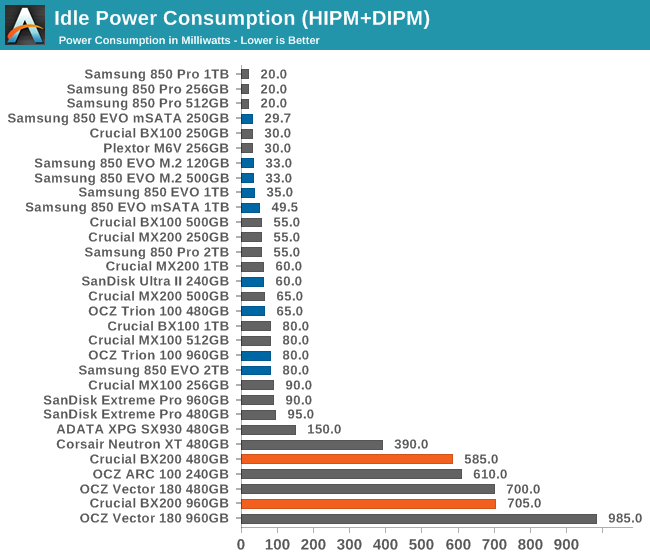The Crucial BX200 (480GB & 960GB) SSD Review: Crucial's First TLC NAND SSD
by Billy Tallis on November 3, 2015 9:00 AM ESTIdle Power Consumption
Many SATA drives are getting close to the limits of what our equipment can measure for power consumption. It's hard to build a meter than has sub-milliwatt accuracy and can withstand the high peak currents drawn by devices like high-performance PCIe drives. Our test rig can't measure the deepest power saving modes (DevSlp), but we can look for any red flags that the intermediate modes aren't working.

The BX200 joins the club of drives than are very poor at managing power without DevSlp support. Its active power consumption and poor efficiency are enough to exclude it from being useful for laptops, so idle power isn't as important, but it's another disapointment.
TRIM Validation
A drive that didn't correctly implement the ATA TRIM command would be very surprising to find today, but it's a quick enough check. The trimcheck tool creates and then deletes a file on the disk, and later checks if the contents of the file are still accessible. In addition to verifying that TRIM is working correctly, this test also demonstrates that, for better or worse, files that are deleted cannot be easily recovered.
Nothing about the drive is completely broken, and TRIM does indeed work.











85 Comments
View All Comments
redzo - Wednesday, November 4, 2015 - link
It's a disaster. I think that Crucial was better of not releasing the damn thing. What were they thinking? The performance gap is huge compared to samsung's evo. This product just shows that samsung rules TLC. All educated buyers will think twice before purchasing it even at 15/20$ lower than this.KAlmquist - Wednesday, November 4, 2015 - link
What makes it a disaster is that Crucial is replacing a successful product (the BX100) with this thing. Keep the BX100 around, give the new drive a designation like AX100, market it as a budget alternative to the BX100, and the drive might be a modest success.When the BX100 disappears, that will leave the Samsung 850 EVO as the paradigm of the SATA SSD sweet spot, with good balance of performance, quality, and attractive pricing.
paulgj - Monday, November 9, 2015 - link
They should name it the BX50 :-)tabascosauz - Wednesday, November 4, 2015 - link
The BX200 should be compared to the SP550 from ADATA. Both are budget drives, both SM2256 (which has left a much crappier first impression than the actually promising SM2246EN), both TLC, yet the SP550 does better as a budget drive.KAlmquist - Friday, November 6, 2015 - link
Yup. I would be excited about the performance of the BX200 if I worked for ADATA.Dritman - Wednesday, November 4, 2015 - link
This is actually embarrassing, to put this product into today's market, at any price. You cannot step backwards THIS far.A crap review is like one of the cheap OCZ drives, except they're understandably bad, because they're so cheap and kinda in line with the price.
With this thing though, it's much worse than anyone could have imagined.
bennyg - Tuesday, November 10, 2015 - link
80mb/s sequential write is not that bad in a SSD. If it were made in 2009.TonyCL6 - Friday, November 6, 2015 - link
The comparison chart should add Samsung 840EVO (planer 19nm TLC) and ADATA SP550 (planer Hynix 16nm TLC) to be more meaningful. It helps users understand the sustain Seq. write (after pSLC cache ran out) performance differences between planer TLC of Samsung 19nm, Toshiba 19nm, Hynix 16nm and Micron 16nm.Kutark - Sunday, November 15, 2015 - link
Can someone answer a question for me. It says these are capable of roughly 500MB/s read and write, however SATA3 obviously saturates around 200. Are those figures for m.2 PCIE versions of the drive or? Cus I see them advertised for the 2.5" SATA drives and im a little confused.I was about to build a skylake setup as a Christmas gift to myself, however I was looking at some of the NVMe drives etc, to get better perf than SATA3 can offer, however, they're significantly more expensive per GB. So, if I can get something with a sustained 500 read/write like this, (or maybe a "pro" version, i.e. non NVME) I'd rather save the money, as realistically in a gamer situation the difference between 500mb/s and 1000 is gonna be negligible.
NJCompguy - Tuesday, January 19, 2016 - link
Despite the abysmal performance of this drive, it's still light years faster then a 5400RPM mechanical drive. I picked up this drive (240GB version) for $65.00 - it made my friends laptop feel brand new after installing a fresh copy of Windows 10. She could not have been happier with this drive. People to often get caught up in the technical details and lose sight of the "big picture" of upgrading from a slow hard drive to an SSD. This drive is perfect for those that just want a laptop to boot up quicker.